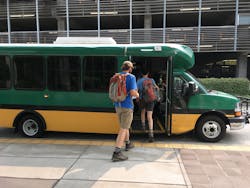Transportation managers need to know that their buses and shuttles are exactly where they need to be, arriving and departing on time, so as not to inconvenience, or worse, strand passengers.
However, even when drivers are thoroughly vetted, qualified and trained, disagreements about the reliability of on-time pickup or drop-off can lead to ill will.
For Doug Dickherber, owner of O’Fallon, Missouri-based Green Way Shuttles, efficiently tracking his bus fleet was key to providing high-quality service. Green Way Shuttles, which specializes in student transportation, serves more than 125 properties at 52 universities across the United States.
“I needed an indisputable way to ensure that the bus was in the right spot at the right time for pick up or drop-off,” says Dickherber. “Our chief complaint from the students we pick up was the driver wasn’t at the stop on time, so they missed their class. The driver would say, ‘I was there.’”
Dickherber says that if a bus leaves early, it may cause a student to miss their class. “We may have to pick up students up at 7 a.m. at an apartment complex and get them to school at 7:15 a.m.. So, if a driver leaves at 6:58 a.m. there may be people waiting at 7 a.m. to get on that could get left behind.”
For fleet managers, achieving certainty about the location and speed of every vehicle—along with increased driver accountability—can be accomplished only through real-time GPS tracking devices.
Drivers that know they are being monitored by such systems are less likely to make unnecessary detours or stops and will no longer need to dispute whether they made an on-time pick up or drop-off.
GPS tracking can be extended to the user side as well. Passengers, through GPS tracking integrated with a smartphone app, can track the whereabouts of their bus.
GPS Grows Up
Although GPS trackers have been around for some time, advances in the technology enable systems to provide more real-time tracking and simplified reporting. Fleet managers don’t want to sift through complex analytical data. They would like real-time information they can act on immediately to correct problems, as well as simplified reports that can provide historical data.
Green Way typically runs daily bus service to and from university campuses from apartment complexes that offer it as a student amenity, with only shuttle clients having access to the bus.
Dickherber says that he has been able to find a GPS tracker that met his criteria at a cost-effective price. His company operates a fleet of more than 110 buses and acquires five to eight new vehicles per year. The buses also have separate video- and audio-monitored security systems from other vendors at additional cost.
The GPS tracking device that Green Way uses provides real-time location updates every 10 seconds, as well as location, speed and idle time alerts if something is amiss. This data is transmitted via satellite and cellular networks to a smartphone or PC on a 24/7 basis.
Operating a company with established routes that buses need to stay on, Dickherber found the GPS tracking device’s geo-sensing capability especially valuable.
“I can put a geo-boundary around a set route, and if the bus gets outside of it, the GPS tracker will email me,” he says. “Then I can figure out, did the driver go and grab a snack, get gas, or go home?”
A specialized app helps parse the data provided by the trackers. “The manager app emails me if a bus leaves the designated area, starts after the assigned time, or stops earlier than expected,” he says. “If it’s 8 a.m. and a bus is supposed to be running but hasn’t started, it emails me so I can ask why the driver hasn’t showed up. If my 1 p.m. bus takes off and isn’t supposed to, it emails me where it started and where it is now so I can figure out why it’s running.”
This makes it easy to resolve disputes, says Dickherber. “If a student says, ‘The bus left early,’ I can quickly find out exactly when the bus left that location.”
Transportation manager reports that analyze historical data, such as on time pickups or drop-offs, also can be emailed without anyone having to open software. The reports can also be customized as needed.
According to Dickherber, the GPS system also helps to improve safety because it has access to speed limits throughout the country in its database. “I have the system set for 5 to 7 miles an hour over the speed limit. So, if a bus exceeds this threshold, the system emails me an alert that includes how fast the bus was going, along with when and where.”
Students riding Green Way buses can immediately locate the buses running in their area by entering a location-specific password into the bus transportation app.
“The app allows students to track where their bus is on their smartphones by GPS and is really accurate,” says Dickherber. “So, if they get to the bus stop at 7:01 and pick up was at 7:00, they can immediately see if they missed their ride or not.”
About the Author
Ben VanAvery
Director of Sales and Marketing, Advanced Tracking Technologies
VanAvery is director of sales and marketing at Advanced Tracking Technologies, a designer and manufacturer of GPS tracking products based in Houston, Texas.
